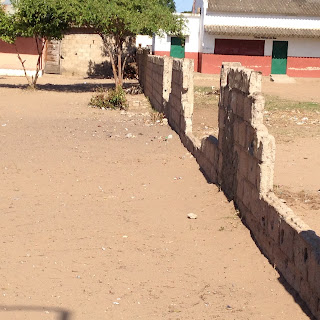 |
| Thorns on a huge trunk of a tree!! THis tree protects itself from things climbing it!!! Sharp like roses. |
|
|
We spent a few days in Swaziland following up on projects there. We were given some projects already started by the area office because they lost some people and cannot keep up. So now we have these to work on. Teril took this picture of a tree trunk. I do not know the name of it, but you would not want to try and climb it! These thorns are as big as your finger and very sharp.

This is a water storage tank that is part of a spring collection source. We asked to see wells or water systems that work and some that do not. This one is working, but needs some repair. The man next to me, Menzi, was one our guides. Next to him (the tall one) is Tualani who drove so fast it even scared me. We were following in our truck and it was all I could do to stay up with him. The other 2 men are community leaders responsible for the water system. This system was built in 2010. The little girl is a daughter of one the men on the left. Her name is Nkosephayo Dlamini. This is a very common last name in Swaziland. It is the name of the kings for a number of generations and with multiple wives the name is one of the most common in the country. (I have to wear a hat; the sun is very intense.)
 |
| Here is a view of the whole system |
This particular area of Swaziland is quite arid and they are also in a severe drought. Everyone is worried and they are trying to figure out how they are going to manage it with the resources they have. We have an open project now that will help them restore 10 wells that needed repair/refurbishing. We are investigating the possibility of proposing a major initiative (managed by a specialist from the US with us as the in-country-coordinators).
Here is a hand pump at the community of Mkhiweni. It is a very good well that has a good capacity and they would like to put in an electric pump and build a reservoir to hold the water so they can service a greater area. But they do not have the funds now for this. Not sure if this will be a part of our project, but whatever we do it will ease the burden and allow them to do more with what they have.

This pump is in the Kutsimuleni community. The well dried up and now they have to return to the stream to get water which is not clean water. The government tried to fix it at first, but determined it would not produce. So now they need to drill in another location. Parts were removed from the pump so they would not be stolen or vandalized. For the most part, the communities do a pretty good job of taking care of the wells. There is a fence around them and a locked gate. People who have had clean water for a while are more vulnerable because they are not accustomed to using the unclean water. Children also are at a higher risk. So the government wants to repair/refurbish existing wells that are not presently producing as a priority.

Here is a water system that was a good producer; an electric pump that filled a reservoir. It was built in 1997. Three years ago the pump went out. The community has the responsibility to pay for the repairs, but were not contributing as they should because of quarreling. As a result the pump was not repaired and has since fallen to thieves and vandals. The community has said they will support the repair, but they have to have some funds up front before anything will happen.
This is dinner at the Summerfield hotel restaurant where we stay when we go to Swaziland. It is a very nice place and the church gets a good rate, so our supervisors recommended it to us. The rooms are duplex type cottages set amidst a beautiful garden with walkways weaving in around the greenery.
KFC is the only fast food place we noticed. We ate there twice; once because I offered to buy our guides for the site tour (Tualani and Menzi) lunch and that is where they wanted to go. We have found food to be less expensive in Swaziland than in Maputo, Mozambique.
 |
| Nice pool; but too cold for my blood |
Here is a zebra skin on the floor of the restaurant. It would be cool to bring one of these home, but I don't know how I would do that! Wouldn't fit in my suit case.
We are hopeful we can be of more help to the country in the area of water. We are also trying to put together a Helping Babies Breath project. It was a project started a couple of years ago, but did not materialize. So we have been tasked to see if we can salvage it with another try. The Ministry of Health does not seem very interested; so I am not sure it will fly. You cannot have a successful project when you have to push it down someone's throat. We will see where it goes.
Here is an unusual "flower" we say at the hotel gardens. I do not know the name of it and have never seen anything quite like it. Very beautiful and unique.
We are very busy trying to cover projects both in Swaziland and here in Maputo. There are 2 projects here we want to start and follow through with. One is with 2 schools to provide materials to fix up the school and some desks; the other is with a school that needs water to a latrine. Will keep you posted.
The mission president would like to see 3 new stakes formed here in the next year. The plan is an aggressive one, but is doable. We are helping by attending ward councils on occasion to encourage the mission plan and get commitments. In spite of the differences that are in each place in the world, what I see are more things where we are alike. People are people and subject to the same weaknesses and challenges; the same strengths and desires. The simple gospel of Jesus Christ truly is the answer to all the problems in the world. Keep living it and be the example to others. It really does make a differnce.
Love to all,
Elder and Sister Petersen, Stan and Teril, Dad and Mom, Grandpa and Grandma
















































